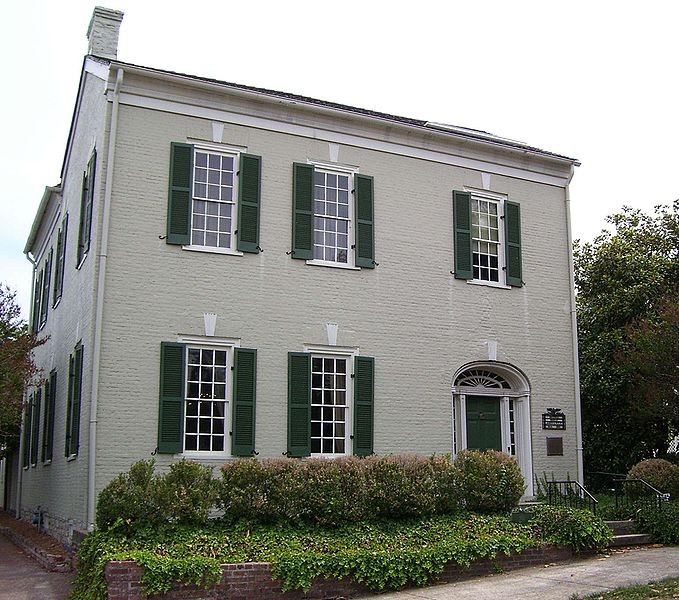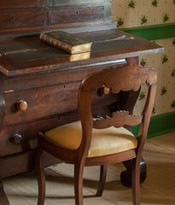President James K. Polk Home and Museum
Introduction
Text-to-speech Audio
Images
Polk Home and Museum exterior

James and Sarah Polk

Desk in Polk home

Backstory and Context
Text-to-speech Audio
After passing the Tennessee state bar exam in 1820, Polk moved to Columbia where he opened his practice. James married Sarah Childress on January 1, 1824.3 The couple never had children. Sarah and James maintained a very close relationship. Sarah served as James’ closest confidant; she was highly respected by nearly everyone who had contact with her. Her elegance and high moral standards contributed greatly to her reputation. A reputation which enhanced the reputation of her husband.4
Polk was elected to the Tennessee House of Representatives in 1823, and then to the U.S. House of Representatives in 1825 where he served as Speaker of the House from 1835 to 1839. A strong supporter of Andrew Jackson and his policies, James K. Polk was instrumental in the passage of much Jacksonian legislation including Jackson’s assault on the corrupt Bank of the United States.5
During the 1840’s, America’s political environment was highly contentious. Issues related to the annexation of Texas, slavery, the Bank of the United States, westward expansion, and relations between the U.S. and European powers contributed to a divided political landscape. At the 1844 Democrat party convention in Baltimore, a hopeless deadlock developed between Martin Van Buren and Lewis Cass for the party’s presidential nomination. Originally offered as a Vice Presidential candidate, James K. Polk received the party’s nomination for president on the ninth ballot. The United States’ first “dark horse” candidate, Polk was not considered a potential candidate before the convention. Polk would face Whig Henry Clay in the general election.6
Texas was annexed by the U.S. during the election, which meant that the primary issue with Texas had become Mexico’s reaction to annexation and northern fears of the expansion of slavery. Polk promised to serve one term in office. He set four primary objectives for his presidency. First, he was determined to replace the Bank of The United States. Second, he sought to adjust U.S. tariff laws. Third, he desired to acquire California and New Mexico. Finally, Polk wanted to acquire sole possession of the Oregon territory from Great Britain. The acquisition of Oregon would balance northern concerns over the expansion of slavery.7
Polk successfully redressed U.S. tariff rates with the passage of the Walker Act in 1846. Later in 1846, Polk gained passage of the Independent Treasury Act that created mechanism to replace the Bank of The United States.8 Polk negotiated a new border between British Canada and the United States that brought the Oregon territory into the U.S. The future states of Oregon, Washington, Idaho, and parts of several others made up this territory. The disputed border between Texas and Mexico became the issue that eventually brought the U.S. and Mexico to war. The United States and Texas claimed the Rio Grande as Texas’ southern border. Polk sent troops to the Rio Grande and Mexico troops crossed the river attacking U.S. soldiers. The United States won the war and in the treaty that followed gained the present states of New Mexico, Arizona, California, Nevada, Utah, and parts of several others.9 With the end of the War with Mexico, Polk had achieved each of his four stated goals for his Presidency.
Polk held true to his promise to serve a single term. After leaving office, James and Sarah embarked on a tour across the country. The former president became ill while in New Orleans but continued on to Nashville where the couple had purchased a new home. James K. Polk died at that home on June 15, 1849 three months after leaving the White House.10 Sarah Polk was forty- five years old when James died, she continued to wear Black mourning clothes until she died forty two years later.11
The James K. Polk House and Museum is the only former residence of James K. Polk that is still standing. The property includes an adjacent home in which two of Polk’s sisters lived at various times and gardens. Artifacts belonging to the Polk’s and other objects from the period are featured by the museum.Cite This Entry
Kent, Michael and Lee Sigmon. "President James K. Polk Home and Museum." Clio: Your Guide to History. June 28, 2015. Accessed April 5, 2025. https://theclio.com/entry/1792

